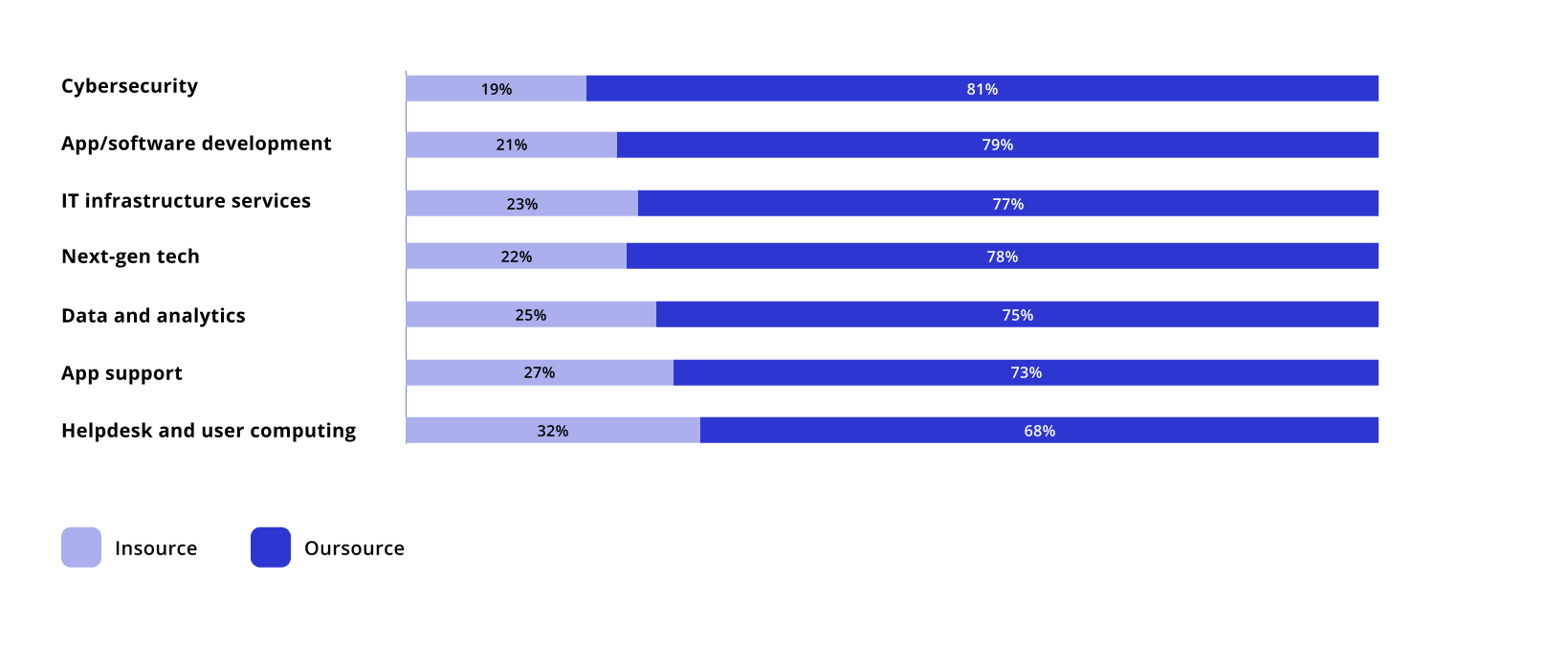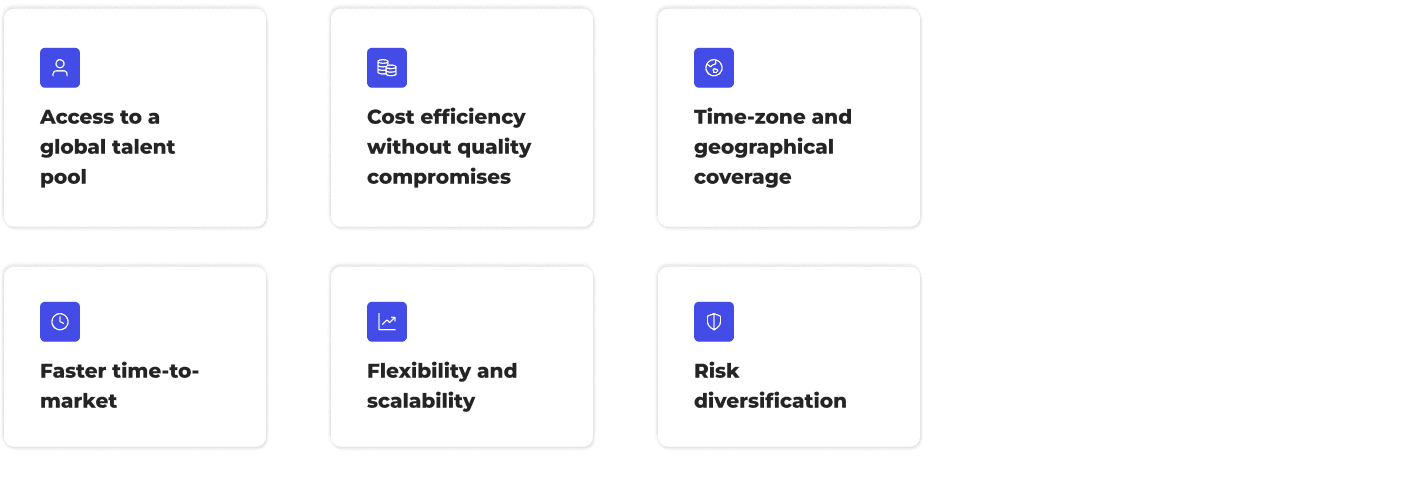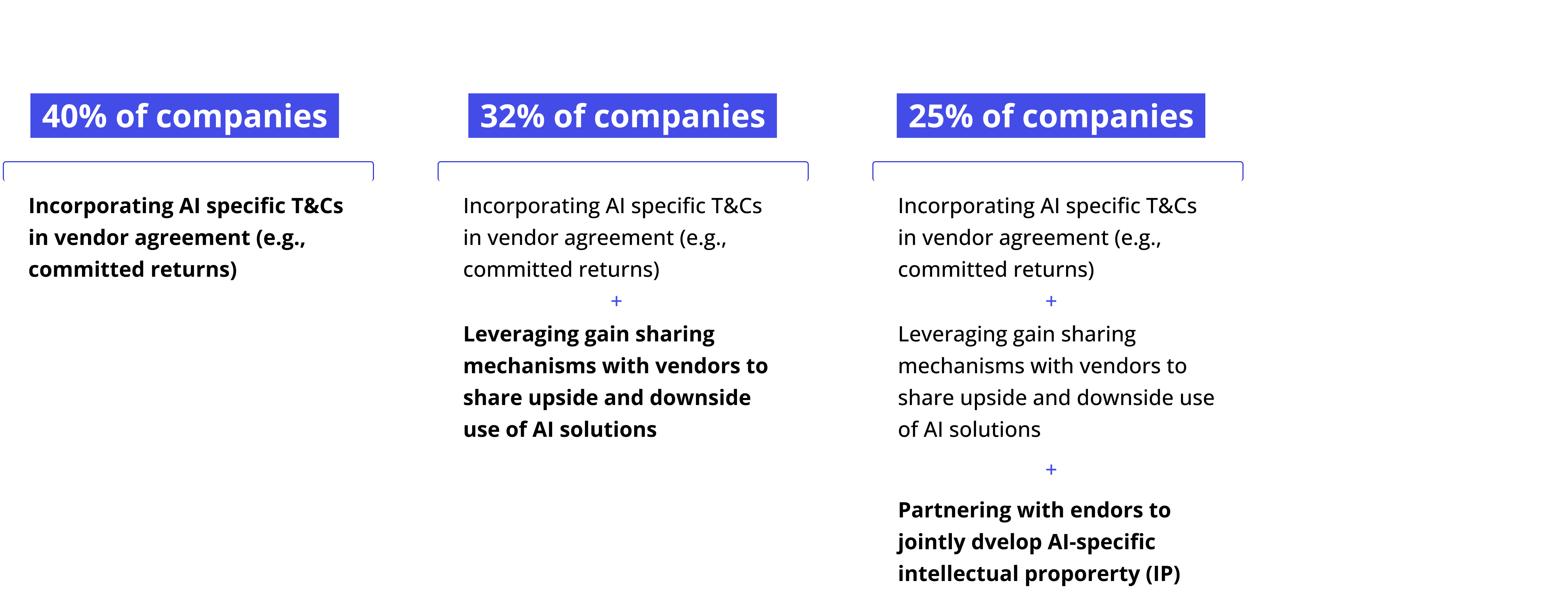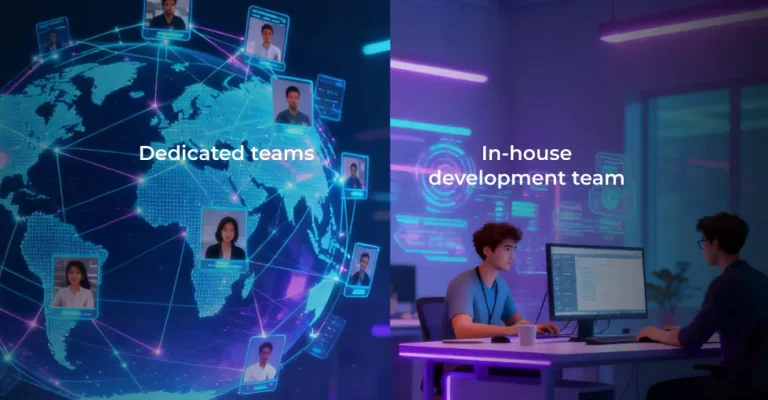If your line of work involves building software products, you’ve likely faced familiar challenges — long hiring cycles, escalating costs, or difficulty attracting and retaining top engineering talent. Many technology leaders have discovered an effective way to overcome these barriers: hiring remote developers through staff augmentation.
In fact, more than 70% of executives surveyed by Deloitte report that their technology and innovation workflows — including software development, IT infrastructure, cybersecurity, data analytics, and emerging technologies — are delivered through third-party models.

This approach enables organizations to accelerate product delivery, boost efficiency, and stay agile amid shifting priorities. It also opens access to a global talent ecosystem, allowing companies to scale development capacity without long-term headcount commitments.
Originally emerging in the IT sector in the late 20th century, staff augmentation has evolved into a strategic tool for executives. Proven engagement models now allow companies to seamlessly integrate augmented developers into their existing workflows, engineering practices, and security standards. The field continues to advance alongside improvements in automation and AI, which enhance the speed and accuracy of remote collaboration.
In this article, we’ll cover everything you need to know to maximize the strategic value of staff augmentation — from its core principles and benefits to vendor selection, talent evaluation, and emerging trends that every technology executive should keep on their radar.
Why hire remote teams of developers
The global software industry moves fast, and so do the demands placed on engineering teams. Hiring remote developers through staff augmentation has become one of the most effective ways for technology companies to stay responsive to evolving priorities, access specialized skills, and manage costs strategically.
1. Access to a global talent pool
According to the latest skills report from HackerRank, 78% of tech leaders admit struggling to find skilled talent. By engaging remote developers, companies tap into a worldwide talent ecosystem, gaining access to specialized expertise that might be scarce or unavailable in their home market. Whether it’s AI/ML engineers, data specialists, or niche framework experts, staff augmentation lets you fill critical skill gaps much faster.
2. Faster time-to-market
Traditional recruitment cycles for senior developers can take months — especially for high-demand skills like AI. Remote team hiring models shorten that timeline dramatically. Many vendors can line up pre-vetted, project-ready engineers in as little as 1–2 weeks, accelerating onboarding and enabling faster delivery of new features or entire products.
3. Cost efficiency without quality compromise
Cost reduction remains the primary driver for outsourcing for 57% of executives. Remote teams help reduce expenses tied to office space, benefits, and overhead while enabling access to regions with more favorable labor economics. Done right, this approach unlocks actionable ways to strategically align quality and cost, all while maintaining high engineering standards.
4. Flexibility and scalability
Perhaps the greatest advantage of remote staff augmentation lies in its elasticity. Teams can be scaled up quickly during high-demand phases — such as product launches or major releases — and scaled down once the workload stabilizes. This model keeps your organization lean without sacrificing delivery capacity.
5. Time-zone flexibility and follow-the-sun collaboration
Depending on your priorities, staff augmentation allows for different collaboration models:
- Nearshore developers and teams work within overlapping hours, ensuring real-time communication and easier integration.
- Offshore or multi-region teams can support “follow-the-sun” operations, providing near-continuous development, QA, or support coverage.
This time-zone flexibility allows companies to optimize productivity and continuity, matching team structure to business rhythm.
6. Better risk diversification
Companies increasingly distribute development work across multiple regions or vendors to minimize operational risk. In case of local disruptions — whether regulatory, geopolitical, or infrastructural — organization can quickly shift work elsewhere without jeopardizing delivery.In essence, hiring remote developers through staff augmentation allows technology companies to move faster, operate smarter, and compete globally — without the long-term rigidity of traditional hiring.

Legal, tax, and compliance considerations when outsourcing developer roles vs. hiring directly
Another strategic advantage of working with a reputable staff augmentation vendor is the ability to offload the legal, tax, and administrative complexities of hiring abroad. Expanding your engineering capacity across borders can pose both challenges and risks — from labor law violations to tax misclassification and data protection breaches. A competent vendor mitigates these risks through established local frameworks and compliance processes:
- Employment and labor law compliance: Vendors act as the official employer for remote developers, ensuring compliance with local labor codes, employment contracts, and termination procedures. This eliminates the need for your company to establish a legal entity or hire local counsel in each jurisdiction.
- Taxation and payroll administration: Vendors manage tax withholding, payroll, and social contributions according to local regulations, preventing risks associated with employee misclassification or noncompliance with international tax treaties.
- IP rights and confidentiality: Properly structured staff augmentation agreements ensure all intellectual property created by remote developers is transferred to the client. Non-disclosure agreements (NDAs) and confidentiality clauses protect sensitive information throughout the engagement.
- Data security and privacy: Reputable vendors follow established standards such as ISO 27001, SOC 2, or GDPR compliance. They also maintain secure infrastructure, access controls, and monitoring practices to safeguard client data.
- Business continuity and risk management: Well-established dev firms maintain redundancy across offices and networks, ensuring continuity even amid emergencies through clear protocols for disaster recovery, data backup, and more.
- Contract transparency and dispute resolution: Contracts should clearly define responsibilities, payment terms, and service levels. Reputable vendors ensure transparency around scope, billing, and termination clauses.
- Cross-border compliance expertise: For companies scaling across multiple regions, vendors with multinational operations (e.g., across Eastern Europe, Latin America, or Asia) provide built-in local compliance and legal coverage in each jurisdiction.
A well-structured staff augmentation partnership eliminates the administrative and compliance friction of international hiring. As a result, you can focus on engineering outcomes — with the confidence that intellectual property, data, and payroll are fully protected.
Staff augmentation vs. freelance and managed services
Staff augmentation, freelancing, and managed services are the three engagement models most commonly used in remote development, and each of the three options serves a distinct purpose. The right model depends on how much control, integration, and accountability you want to retain over the work being done.
| Criteria | Staff augmentation | Freelancers | Managed services |
| Team integration | Developers become part of the client’s team, working within its tools, processes, and sprints | Independent contributors, loosely integrated; client fully manages the collaboration | Vendor provides an autonomous team that owns delivery end to end |
| Management control | Client manages daily tasks and priorities, while the vendor is responsible for deliverables | Full client control, but often with minimal oversight capabilities | Vendor manages execution, delivery, and quality metrics |
| Talent vetting | Vendor pre-vets and supplies top-tier engineers matching client requirements | Quality varies widely; vetting and onboarding fall to the client | Vendor is fully responsible for team quality and performance |
| Scalability | Easy to scale up or down as needs change; flexible commitments | Scaling depends on freelancer availability | Scaling is handled by the vendor but typically requires a new SOW or renegotiation |
| Cost structure | Transparent rates per engineer; predictable monthly costs | Hourly or per-task rates; low entry cost but limited continuity | Fixed-price or retainer model; often higher total cost for managed accountability |
| Communication | Continuous and structured; daily syncs with client team | Irregular or ad-hoc, depending on freelancer’s schedule | Managed via vendor-side PMs and reporting dashboards |
| Accountability and risk | Shared accountability; vendor handles HR, compliance, and payroll | All responsibility lies with the client | Vendor assumes full accountability for outcomes |
| Best for | Companies seeking to expand engineering capacity fast without losing control | Small projects, prototypes, or short-term one-off tasks | Large-scale initiatives requiring fully managed delivery |
To sum up, use staff augmentation when you want to stay hands-on with delivery while scaling your capacity fast and keeping quality consistent. Choose freelancers for isolated, low-risk tasks that don’t require deep integration or long-term collaboration. Opt for managed services when you need a vendor to take full ownership of outcomes — including project management, delivery risk, and service-level compliance.
Comparing key locations for hiring remote developers
When evaluating remote development destinations, executives typically weigh time zone alignment, talent quality, cost efficiency, and cultural fit. The table below compares Eastern Europe, Latin America, and Asia, the three major regions most commonly used for staff augmentation.
| Eastern Europe | Latin America | Asia | |
| Key countries | Poland, Ukraine, Romania, Bulgaria, Czech Republic | Argentina, Brazil, Colombia, Mexico, Chile | India, Philippines, Vietnam, Malaysia, Indonesia |
| Time zone alignment | 2–7 hours overlap with US and EU | 6+ overlapping working hours with North America | Large gap with EU/US; suitable for follow-the-sun models |
| Talent quality | Excellent STEM education, strong English, mature Agile practices | Strong collaboration culture, competitive skills for web and mobile development | Vast talent pool, experienced outsourcing infrastructure |
| Cultural compatibility | High compatibility with Western work culture | High cultural and communication alignment with US | Varies widely; may require adaptation in management and communication |
| Cost efficiency | Moderate cost savings vs. Western Europe/US | Competitive rates with strong ROI | Most cost-effective overall |
| Common strengths | Strong engineering culture, security standards, and innovation mindset | Nearshore proximity, English fluency, flexibility | Scale, cost efficiency, and broad technical coverage |
| Best for | Enterprise-grade projects, fintech, AI/ML, long-term partnerships | Agile product teams, startups, nearshore outstaffing | Support and maintenance, well-defined large-scale projects |
Key challenges and risks of staff augmentation and remote development
Staff augmentation offers clear advantages across regions, but real-life outcomes always depend on the quality of your vendor. A wrong choice of a partner can slow delivery, inflate costs, or expose your company to compliance and security risks. Below are the most common pitfalls executives should be mindful of:
- Unreliable delivery: Teams may start strong but lose momentum due to weak project management or overcommitment across multiple clients. Issues like these can ripple across your organization, causing missed milestones across departments.
- Inconsistent quality: Superficial vetting may result in developers delivering unstable code, poor documentation, or suboptimal architectural choices, leading to buggy software and technical debt.
- Budget overruns: Inexperienced or disorganized vendors may underestimate effort, mismanage scope, or fail to communicate the impact of changes early. Oversights of this kind can lead to budget creep and increased internal management overhead.
- Weak communication: Vendors that communicate reactively (i.e., waiting for clients to raise issues) can pose an unnecessary challenge for project management. Mature partners communicate proactively — sharing status updates, risks, and solutions.
- Security and compliance exposure: Without robust governance, remote engagements can lead to IP leakage, data mishandling, or noncompliance with local labor and tax laws.
- High talent turnover: Even in staff augmentation setups, developers who feel disconnected or under-supported tend to leave. Vendors who neglect developer engagement often fail to maintain healthy delivery velocity or even ensure project continuity.
- Cultural mismatch: Misaligned communication styles or work habits can create friction, slowing decision-making and reducing trust.
- Strategic misalignment: Transactional vendors often prioritize short-term delivery over long-term value, limiting innovation and collaboration.
In short, hiring remote developers is less about where the talent comes from and more about who manages it. A capable vendor ensures speed, quality, and compliance — while a weak one multiplies risk at every level of execution.
How to evaluate and select the right vendor
Given the above pitfalls, choosing a staff augmentation partner is a critical decision that impacts the success of your remote development initiative. The best vendors act as extensions of your team — providing vetted experts, transparent communication, and strategic alignment. The worst add friction, opacity, and risk.
When evaluating potential partners, focus on the following dimensions:
- Track record and domain expertise: Look for a proven history of delivering solutions in your industry and tech stack. Case studies, client testimonials, and high B2B ratings are reliable indicators of consistent quality.
- Talent sourcing and vetting: Assess how the vendor identifies, tests, and selects developers. Strong partners maintain in-house recruitment and screening pipelines, with technical and cultural assessments aligned to your needs.
- Candidate quality: Evaluate the talent they line up for interviews — not only on technical skills but also on motivation, ownership, and communication style. Consistency here reflects vendor maturity.
- Communication practices: Observe how the vendor interacts with you during early conversations. How do they communicate? Do they set realistic expectations or overpromise? Responsiveness and transparency are leading indicators of the quality of long-term collaboration.
- Pricing transparency: Extremely low rates may signal corner-cutting or hidden costs. Conversely, unreasonably high rates don’t always equate to superior talent. The right partner offers transparent, predictable pricing aligned with market benchmarks.
- Geographical presence and time zone coverage: Confirm that their delivery centers operate within compatible time zones and can support your working hours. Mature vendors can often offer both nearshore options and “follow-the-sun” capabilities.
- Security and compliance maturity: Check for established IP protection policies, secure infrastructure, and compliance with data privacy and labor laws. ISO, SOC 2, or GDPR certifications add credibility.
- Business continuity planning: Reliable partners have strategies for mitigating disruptions — from backup teams to redundant infrastructure and disaster recovery protocols.
- Contract clarity: Contracts should clearly define engagement terms, SLAs, and IP ownership. Avoid vague commitments or open-ended pricing models that can introduce risk.
Red flags to watch out for:
- Overpromising on timelines or talent availability
- Inconsistent communication or slow response times
- Lack of transparency in developer credentials or rates
- Absence of client references
- Poor understanding of your industry or technical domain
Selecting the right vendor determines whether staff augmentation becomes a tactical quick fix or a long-term driver of speed, quality, and innovation. The right vendor turns staff augmentation into a reliable, scalable growth engine — one that strengthens delivery capacity without compromising control or quality.
Staff augmentation best practices for team integration, vetting, and more
Outcomes in staff augmentation depend less on the model itself and more on how you execute it. Leading organizations treat vendor relationships as an extension of their own engineering culture — focusing on transparency, integration, and continuous improvement.
Here are eight proven best practices to maximize the ROI of your augmented teams:
- Prioritize reliability over headcount or cost. Choose vendors known for consistent delivery, structured project management, and long-term client relationships rather than just quick scaling.
- Vet for technical and cultural fit. Strong developers combine engineering skill with clear communication and adaptability to your internal processes.
- Ensure transparent cost and scope management. Align on KPIs, delivery milestones, and change control from day one to prevent budget creep.
- Foster proactive communication. Expect partners to share status updates, flag risks early, and propose improvements — not just react to issues.
- Protect security and compliance. Verify data protection policies, IP governance, and labor law compliance in each vendor’s operating region.
- Invest in retention and engagement. Encourage vendors to maintain high developer satisfaction through mentorship, recognition, and training — key to reducing churn and preserving velocity.
- Bridge cultural and time zone gaps. Build shared rituals such as overlapping standups or joint retrospectives to sustain alignment.
- Think beyond transactions. The best outcomes come from vendors who act as strategic partners — contributing ideas, not just code.
In short, staff augmentation succeeds when managed as a partnership. With the right governance, it becomes a lever for speed, quality, and sustained innovation.
Future trends and strategic outlook
As the global engineering landscape evolves, several key trends are reshaping how companies approach remote hiring and distributed collaboration.
AI-powered outsourcing
AI has a comprehensive impact throughout the complete outsourcing service model, from staffing to delivery. Vendors increasingly use AI to improve the precision of skill-based candidate matching. On the delivery side, AI copilots and automated testing tools are helping distributed teams achieve faster, higher-quality outcomes. Today, 57% of organizations are establishing new outsourcing partnerships with a focus on AI. As collaboration styles and AI adoption mature, organizations even launch joint AI initiatives with their vendors.
Outsourcing strategies leveraged by AI leaders in 2025

Source: Deloitte outsourcing survey 2024
Hybrid and distributed-by-design organizations
The future of engineering teams is neither fully on-site nor entirely remote — it’s hybrid and distributed by design. Enterprises are building core teams in strategic hubs while extending capacity through remote experts in nearshore and offshore locations. This model balances collaboration effectiveness and cost efficiency, enabling 24/7 productivity across time zones.
Security-first partnerships
As data privacy regulations tighten and AI-driven workflows multiply, security and compliance are taking center stage. Future-ready vendors invest in advanced cybersecurity protocols, secure development practices like DevSecOps, and transparent governance models that minimize exposure and strengthen client trust.
Outcome-based engagement models
The traditional hourly billing structure is gradually giving way to outcome-based agreements, where vendors share accountability for project deliverables, timelines, and KPIs. This shift aligns incentives, reduces administrative friction, and deepens the partnership dynamic between clients and augmentation providers.
Nearshoring and regional diversification
Executives are increasingly opting for nearshore partnerships that balance time zone overlap with cost efficiency. At the same time, diversification across multiple regions — Eastern Europe, Latin America, and Southeast Asia — is becoming a common risk mitigation strategy to ensure continuity and access to specialized skills.
Summing it all up
Staff augmentation has evolved far beyond its origins as a hiring solution. Today, it’s a strategic tool that helps technology leaders stay agile, accelerate delivery, and scale innovation — without the delays or overhead of traditional hiring.
When done right, this model extends your internal capabilities, giving you access to world-class engineers, designers, and AI/data experts who align with your processes and goals. The key lies in choosing the right partner, one that balances technical depth with communication maturity, operational discipline, and cultural fit.
If you’re exploring how staff augmentation can strengthen your engineering capabilities, consider starting with a partner like AgileEngine — a global software development company that combines top-1% talent with AI-driven delivery practices to help enterprises ship faster, innovate smarter, and achieve measurable business outcomes.
FAQs
Can remote developers be part of an Agile development team?
Absolutely. Remote developers can seamlessly integrate into Agile workflows using tools such as Jira, Slack, and GitHub. Daily standups, sprint reviews, and retrospectives can be run effectively in distributed formats, ensuring visibility, accountability, and collaboration across time zones.
What are some tips to improve the recruitment process of remote workers?
Start with a detailed role description that clearly outlines project goals, required skills, and expectations. Involve your senior engineers or team leads in technical interviews to assess real-world problem-solving skills. Finally, provide timely, structured feedback — it keeps candidates engaged and reflects well on your employer brand.
What types of engagement models do you offer for hiring remote developers?
AgileEngine offers flexible collaboration models, including staff augmentation (individual experts joining your team), dedicated teams (self-managed groups focused on your project), and solutions teams (a managed services model focused on end-to-end delivery of digital solutions).
How do you handle time zone differences and language barriers in remote teams?
Effective distributed teams rely on asynchronous communication tools (Slack, Confluence, Loom, etc.) and well-documented processes. Nearshore locations can minimize time-zone friction, and regular sync-ups help maintain personal connection. Just like most top vendors, we also screen candidates for English proficiency and cross-cultural collaboration skills.
What are the best practices for interviewing remote developers?
Combine technical and behavioral evaluation. Use coding challenges or live pair-programming to gauge problem-solving skills, and include situational questions that assess communication, teamwork, and ownership — test for clarity, adaptability, and the ability to collaborate across cultures.
How do I track the productivity of remote developers?
Use measurable KPIs such as sprint velocity, code quality, issue resolution time, and peer review feedback. Modern tools like Jira, Linear, and Git analytics make progress transparent. Focus on outcomes and impact rather than micromanaging activity levels.
How long does it take on average to launch a remote development team?
With an established staff augmentation partner, you can usually start within 2–4 weeks. This timeframe includes role scoping, candidate selection, interviews, and onboarding. The majority of mainstream technical stacks have pre-vetted talent pools, which can further shorten timeframes.
How much does it cost to hire remote developers?
Rates vary based on region, expertise, and engagement model. For senior-level talent, you can expect to save over 50% for software engineering roles and 35–60% for UI/UX design roles compared to US experts. See our latest tech salary report for more details.













